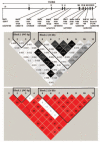Analysis of genetic variation in Akt2/PKB-beta in severe insulin resistance, lipodystrophy, type 2 diabetes, and related metabolic phenotypes
- PMID: 17327441
- PMCID: PMC2672155
- DOI: 10.2337/db06-0921
Analysis of genetic variation in Akt2/PKB-beta in severe insulin resistance, lipodystrophy, type 2 diabetes, and related metabolic phenotypes
Abstract
We previously reported a family in which a heterozygous missense mutation in Akt2 led to a dominantly inherited syndrome of insulin-resistant diabetes and partial lipodystrophy. To determine whether genetic variation in AKT2 plays a broader role in human metabolic disease, we sequenced the entire coding region and splice junctions of AKT2 in 94 unrelated patients with severe insulin resistance, 35 of whom had partial lipodystrophy. Two rare missense mutations (R208K and R467W) were identified in single individuals. However, insulin-stimulated kinase activities of these variants were indistinguishable from wild type. In two large case-control studies (total number of participants 2,200), 0 of 11 common single nucleotide polymorphism (SNPs) in AKT2 showed significant association with type 2 diabetes. In a quantitative trait study of 1,721 extensively phenotyped individuals from the U.K., no association was found with any relevant intermediate metabolic trait. In summary, although heterozygous loss-of- function mutations in AKT2 can cause a syndrome of severe insulin resistance and lipodystrophy in humans, such mutations are uncommon causes of these syndromes. Furthermore, genetic variation in and around the AKT2 locus is unlikely to contribute significantly to the risk of type 2 diabetes or related intermediate metabolic traits in U.K. populations.
Figures


Similar articles
-
Contribution of the Akt2 gene to type 2 diabetes in the Chinese Han population.Chin Med J (Engl). 2011 Mar;124(5):725-8. Chin Med J (Engl). 2011. PMID: 21518566
-
Akt2 Gene common allelic variants in insulin resistance and the metabolic syndrome.Nutr Metab Cardiovasc Dis. 2008 May;18(4):263-70. doi: 10.1016/j.numecd.2007.01.005. Epub 2007 Jun 18. Nutr Metab Cardiovasc Dis. 2008. PMID: 17576055
-
Evaluating the role of LPIN1 variation in insulin resistance, body weight, and human lipodystrophy in U.K. Populations.Diabetes. 2008 Sep;57(9):2527-33. doi: 10.2337/db08-0422. Epub 2008 Jun 30. Diabetes. 2008. PMID: 18591397 Free PMC article.
-
Metabolism and insulin signaling in common metabolic disorders and inherited insulin resistance.Dan Med J. 2014 Jul;61(7):B4890. Dan Med J. 2014. PMID: 25123125 Review.
-
Impact of genetic variation of PPARgamma in humans.Mol Genet Metab. 2004 Sep-Oct;83(1-2):93-102. doi: 10.1016/j.ymgme.2004.08.014. Mol Genet Metab. 2004. PMID: 15464424 Review.
Cited by
-
Severe Insulin Resistance Syndromes: Clinical Spectrum and Management.Int J Mol Sci. 2025 Jun 13;26(12):5669. doi: 10.3390/ijms26125669. Int J Mol Sci. 2025. PMID: 40565151 Free PMC article. Review.
-
AKT1 Regulates Endoplasmic Reticulum Stress and Mediates the Adaptive Response of Pancreatic β Cells.Mol Cell Biol. 2020 May 14;40(11):e00031-20. doi: 10.1128/MCB.00031-20. Print 2020 May 14. Mol Cell Biol. 2020. PMID: 32179553 Free PMC article.
-
Insulin receptor signaling in normal and insulin-resistant states.Cold Spring Harb Perspect Biol. 2014 Jan 1;6(1):a009191. doi: 10.1101/cshperspect.a009191. Cold Spring Harb Perspect Biol. 2014. PMID: 24384568 Free PMC article. Review.
-
Homeostasis and the importance for a balance between AKT/mTOR activity and intracellular signaling.Curr Med Chem. 2012;19(22):3748-62. doi: 10.2174/092986712801661130. Curr Med Chem. 2012. PMID: 22680924 Free PMC article. Review.
-
Lipodystrophic laminopathies: Diagnostic clues.Nucleus. 2018 Jan 1;9(1):249-260. doi: 10.1080/19491034.2018.1454167. Nucleus. 2018. PMID: 29557732 Free PMC article. Review.
References
-
- Taniguchi CM, Emanuelli B, Kahn CR. Critical nodes in signalling pathways: insights into insulin action. Nat Rev Mol Cell Biol. 2006;7:85–96. - PubMed
-
- Cho H, Mu J, Kim JK, Thorvaldsen JL, Chu Q, Crenshaw EB, 3rd, Kaestner KH, Bartolomei MS, Shulman GI, Birnbaum MJ. Insulin resistance and a diabetes mellitus-like syndrome in mice lacking the protein kinase Akt2 (PKB beta) Science. 2001;292:1728–1731. - PubMed
-
- George S, Rochford JJ, Wolfrum C, Gray SL, Schinner S, Wilson JC, Soos MA, Murgatroyd PR, Williams RM, Acerini CL, Dunger DB, Barford D, Umpleby AM, Wareham NJ, Davies HA, Schafer AJ, Stoffel M, O’Rahilly S, Barroso I. A family with severe insulin resistance and diabetes due to a mutation in AKT2. Science. 2004;304:1325–1328. - PMC - PubMed
-
- Barrett JC, Fry B, Maller J, Daly MJ. Haploview: analysis and visualization of LD and haplotype maps. Bioinformatics. 2005;21:263–265. - PubMed
Publication types
MeSH terms
Substances
Grants and funding
LinkOut - more resources
Full Text Sources
Medical
Miscellaneous

